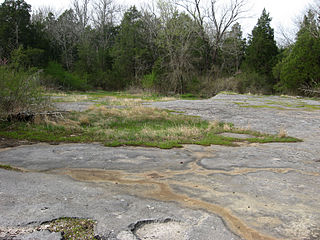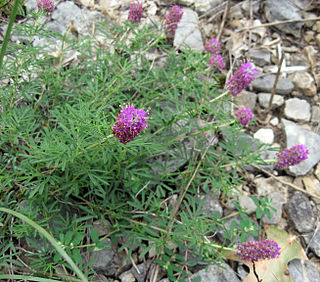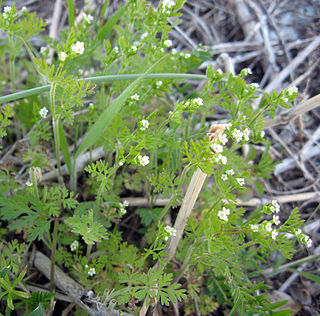The Nashville Basin, also known as the Central Basin, is a term often used to describe the area surrounding Murfreesboro, Tennessee, in which Nashville is located. The Central Basin was caused by an uplifting which produced a dome known as the Nashville Dome. The Nashville Dome is evidenced by the underlying rock strata that all dip downwards away from Nashville. The uplifting of the Nashville Dome fractured overlying strata, making it more easily eroded and thus the "dome" resulted in a "basin". Uplifted strata in the center of a geological dome have higher potential erosive energy than the surrounding strata, because they are physically higher. Erosion thus acts on the uplifted area at a greater rate than on the surrounding flat-lying area, creating a low area, i.e. a basin. This area is more correctly referred to as the "Central Dome" of Tennessee.

A calcareous glade is a type of ecological community that is found in the central eastern United States. Calcareous glades occur where bedrock such as limestone occurs near or at the surface, and have very shallow and little soil development. Because of the shallow soil and the extreme conditions created by it, trees are often unable to grow in the glades. This creates a habitat that is usually sunny, dry, and hot. Calcareous glade vegetation is more similar to that of a desert habitat than a grassland, being dominated by small spring annuals with occasional geophytic or succulent perennials.

Echinacea tennesseensis, also known as the Tennessee coneflower or Tennessee purple coneflower, is a flowering plant in the family Asteraceae, endemic to the cedar glades of the central portion of the U.S. state of Tennessee.

Astragalus bibullatus, the limestone glade milkvetch or Pyne's ground plum, is an endangered species of flowering plant that is endemic to the cedar glades of the central basin of Tennessee in the United States. It is found in only eight populations located within a few kilometers of each other in Rutherford County, Tennessee.

Lobelia scaevolifolia is a species of the plant family Campanulaceae. It is endemic to the island of Saint Helena in the South Atlantic Ocean. It was at one time placed as the only species, Trimeris scaevolifolia, in the genus Trimeris. Its common name is St. Helena lobelia.

Elsie Quarterman was a prominent plant ecologist. She was a Professor Emerita at Vanderbilt University.

Cedars of Lebanon State Park is a state park in Wilson County, Tennessee, in the southeastern United States. It consists of 900 acres (364 ha) situated amidst the 9,420-acre (3,810 ha) Cedars of Lebanon State Forest. The park and forest are approximately 10 miles (16 km) south of Lebanon, Tennessee.

Paysonia lyrata is a rare species of flowering plant in the family Brassicaceae known by the common name lyreleaf bladderpod. It is endemic to Alabama in the United States, where it is known from only three occurrences. It is federally listed as a threatened species.

Astragalus tennesseensis is a species of flowering plant in the legume family known by the common name Tennessee milkvetch. It is native to the United States, where it is known from Illinois, Indiana, Tennessee and Alabama. Most of the occurrences are in Tennessee.

The Interior Low Plateaus are a physiographic region in eastern United States. It consists of a diverse landscape that extends from north Alabama across central Tennessee and Kentucky into southern Illinois, Indiana, and Ohio. Its natural communities are a matrix of temperate forests, woodlands, and prairies.

Leavenworthia is a genus of flowering plants in the family Brassicaceae. It includes about eight species native to the southern and southeastern United States. They are known generally as gladecresses.

Viola egglestonii, commonly known as glade violet, is a species herbaceous plant in the violet family. It is native to a small area of eastern North America, only being found in limestone cedar glades of the Interior Low Plateau and Ridge and Valley ecoregions of Alabama, Georgia, Indiana, Kentucky, and Tennessee.

Pediomelum subacaule is a species of flowering plant in the legume family known by the common names Nashville breadroot and whiterim scurfpea. It is native to a small area of Eastern North America, only being found in limestone cedar glades of the Interior Low Plateau and Ridge and Valley ecoregions of Alabama, Georgia, and Tennessee.

Grindelia lanceolata is a species of flowering plant in the family Asteraceae known by the common name narrowleaf gumweed.
Leavenworthia crassa is a species of flowering plant in the family Brassicaceae, known commonly as the fleshy-fruit gladecress. It is endemic to Alabama in the United States, where it occurs in only two counties. It is "likely one of the most imperiled plant species in the Southeast," and the United States Fish and Wildlife Service issued a final rule listing it as an endangered species in 2014.

Dalea gattingeri, commonly called purpletassles or Gattinger prairie clover, is a species of flowering plant in the legume family. It is native to the Southeastern United States, where it is restricted to limestone cedar glades of Tennessee, Alabama, Georgia, Missouri, and Arkansas. Its populations are widely dispersed and geographically small, with most populations being found in the Nashville Basin.

Solidago gattingeri, common name Gattinger's goldenrod, is a species of plant that is a goldenrod. It is native only to the Ozark Mountains of Arkansas and Missouri and to the Nashville Basin of Tennessee. Its preferred habitat is cedar glades, cedar barrens, and limestone outcrops. It is adapted to dry habitats.

Chaerophyllum tainturieri, known by the common names hairyfruit chervil and southern chervil, is an annual forb native to the south-eastern United States, with disjunct populations in Arizona and New Mexico. It is a common plant, found in glades, fields, and disturbed areas. It produces small white umbels of flowers in the spring.

Sedum pulchellum is a species of flowering plant in the family Crassulaceae known by the common names widowscross and widow's cross. It is native to calcareous areas of the South-Central and Southeastern United States and where it is found on flat rock outcrops, particularly cedar glades. Most populations are in the Interior Low Plateau, and Ozark and Ouachita Mountains.

















